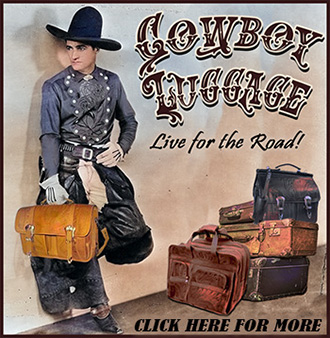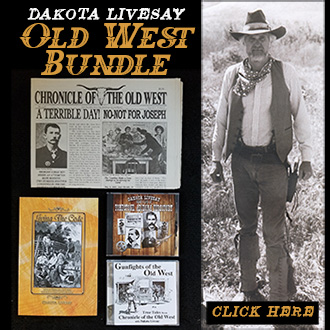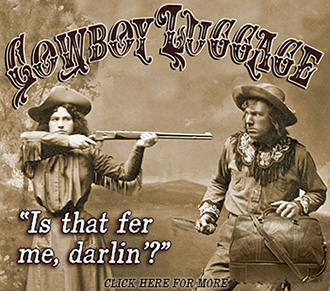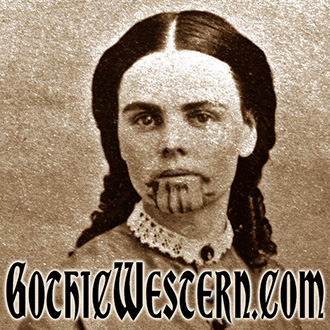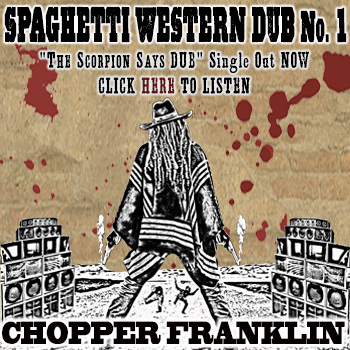On October 11, 1 940, the famous cowboy actor Tom Mix is killed in a freak car accident near his ranch in Florence, Arizona. He was driving his single-seat roadster with luggage on the rear shelf of the car. Tom was traveling along a straight desert road, when he unknowingly came to a bridge spanning a shallow gully that was out. When his car went down into the gully a heavy suitcase flew off the rear shelf of his car and crushed him.
940, the famous cowboy actor Tom Mix is killed in a freak car accident near his ranch in Florence, Arizona. He was driving his single-seat roadster with luggage on the rear shelf of the car. Tom was traveling along a straight desert road, when he unknowingly came to a bridge spanning a shallow gully that was out. When his car went down into the gully a heavy suitcase flew off the rear shelf of his car and crushed him.
Tom Mix had been one of the biggest silent movies stars in Hollywood during the 1920’s, appearing in more than 300 westerns and making as much as $10,000 a week. Unlike most of the actors appearing in westerns, Mix had actually worked as a cowboy, and had been a Texas Ranger.
In 1906, Mix joined a Wild West show, and four years later he started acting in motion pictures. He helped define the classic image of the western movie cowboy as a rough riding, quick-shooting defender of right and justice, an image that would be copied by hundreds of other actors who followed him.
With the coming of talking pictures, Mix’s movie career stalled. When he died in 1940 at the age of 60, he had lost most of his wealth and was largely forgotten.
Today a black iron silhouette of a riderless bronco marks the site of Mix’s death on the highway about 17 miles south of Florence, Arizona.
March 11, 2025 | Categories: Old West Myth & Fact | Tags: Tom Mix is killed in a freak car accident | Comments Off on Tom Mix is Killed in a Freak Car Accident
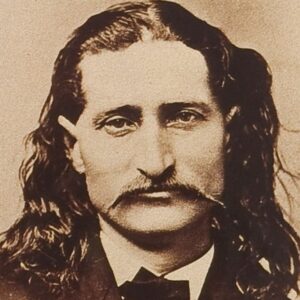 How did Wild Bill Hickok’s first job as sheriff go for him? Well, on September 27 back in 1869, Ellis County Sheriff Wild Bill Hickok and his deputy responded to a disturbance by a local ruffian named Samuel Strawhun and several of his drunken buddies at John Bitter’s Beer Saloon in Hays City, Kansas. Hickok ordered the men to stop, Strawhun turned to attack him, and Hickok shot and killed him.
How did Wild Bill Hickok’s first job as sheriff go for him? Well, on September 27 back in 1869, Ellis County Sheriff Wild Bill Hickok and his deputy responded to a disturbance by a local ruffian named Samuel Strawhun and several of his drunken buddies at John Bitter’s Beer Saloon in Hays City, Kansas. Hickok ordered the men to stop, Strawhun turned to attack him, and Hickok shot and killed him.
This was typical of Wild Bill’s approach to a confrontation. As one cowboy said, Hickok would stand “with his back to the wall, looking at everything and everybody under his eyebrows–just like a mad old bull.”
But some Hays City citizens wondered if their new cure wasn’t worse than the disease.
In September 1869, his first month as sheriff, Hickok killed two men. The first was Bill Mulvey, who was galloping through town on a rampage, drunk, shooting out mirrors and whisky bottles behind bars. Citizens warned Mulvey to behave, because Hickok was sheriff. Mulvey angrily declared that he had come to town to kill Hickok. When he saw Hickok, he leveled his cocked rifle at him. Hickok waved his hand past Mulvey at some supposed onlookers and yelled, “Don’t shoot him in the back; he is drunk.” Mulvey wheeled his horse around to face those who might shoot him from behind, and before he realized he had been fooled, Hickok shot him through the temple.
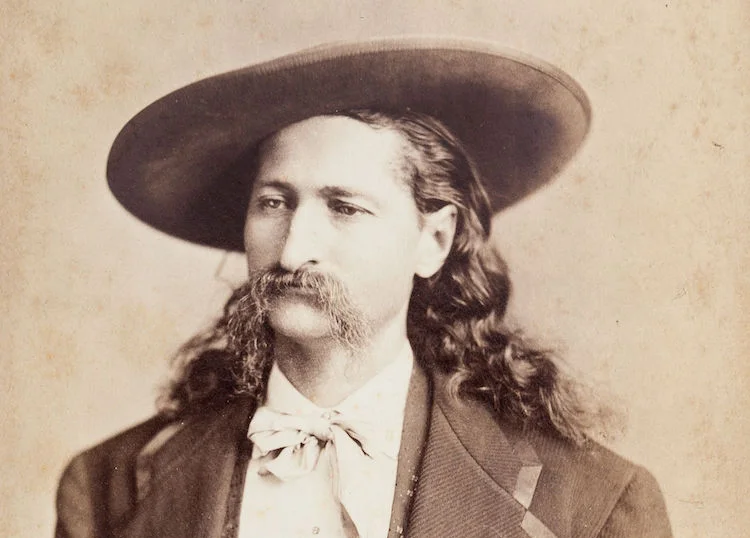
The second man killed by Hickok was the aforementioned Samuel Strawhun, a cowboy, who was causing a disturbance in a saloon at 1:00 am on September 27, when Hickok and Lanihan went to the scene. Strawhun “made remarks against Hickok”, and Hickok killed him with a shot through the head. Hickok said he had “tried to restore order”. At the coroner’s inquest into Strawhun’s death, despite “very contradictory” evidence from witnesses, the jury found the shooting justifiable.
On July 17, 1870, Hickok was attacked by two troopers from the 7th U.S. Cavalry, Jeremiah Lonergan and John Kyle (sometimes spelled Kile), in a saloon. Lonergan pinned Hickok to the ground, and Kyle put his gun to Hickok’s ear. When Kyle’s weapon misfired, Hickok shot Lonergan, wounding him in the knee, and shot Kyle twice, killing him. Hickok again lost his re-election bid to his deputy.
During the regular November election later that year, the people expressed their displeasure, and Hickok lost to his deputy, 144-89. Though Wild Bill Hickok would later go on to hold other law enforcement positions in the West, his first attempt at being a sheriff had lasted only three months.
February 14, 2025 | Categories: Old West Myth & Fact | Tags: Wild Bill Hickok's First Job as Sheriff | Comments Off on Wild Bill Hickok’s First Job as Sheriff
 Back in 1866 Robert Leroy Parker was born in Beaver, Utah Territory. But we know him as Butch Cassidy.
Back in 1866 Robert Leroy Parker was born in Beaver, Utah Territory. But we know him as Butch Cassidy.
Supposedly, he picked up the name “Butch” from the short period of time he worked in a Rock Springs, Wyoming butcher shop. The last name came from a minor criminal mentor by the name of Mike Cassidy…I also suspect he didn’t want to bring shame on his strict Mormon family by using Parker.
Although Butch’s organizational skills and personality were probably suited more for a legitimate business life, he assembled a group of ruffians known as the “wild bunch.” Even though they could be considered misfits, Butch was able to meld them into a sophisticated criminal operation.
By the 1900’s the wild days of the West were fading and law enforcement was becoming more effective. So Butch, The Sundance Kid and Etta place fled to Argentina.
Here’s where legend and fact get blurry. Some say Butch Cassidy and the Sundance Kid were killed by Bolivian troops. However members of his family maintain Butch came back to the United States and died of old age under another name.
Just as an aside. There are more than a dozen Old West outlaws, including Billy the Kid, who were supposedly not really killed, and they lived a long life under an alias. Sometimes I wonder if any Old West outlaw was ever killed.
January 1, 2022 | Categories: Old West Myth & Fact | Comments Off on Robert Leroy Parker – We Know Him as Butch Cassidy
We all think of Doc Holliday as a deadly shootist, killing scores of men. But, in this case our thinking is wrong. In reality, it can only be verified that Doc killed two men…One of them back in 1879. Here is some Doc Holliday – Myth and Fact: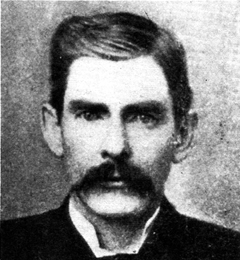
Doc Holliday was a partner in a saloon in Las Vegas, New Mexico. A former army scout named Mike Gordon tried to persuade one of Holliday’s saloon girls to quit her job and run away with him. When she refused, Gordon became upset, and he went out to the street and began to fire bullets into the saloon. After the second shot, Holliday calmly stepped out of the saloon and dropped Gordon with a single shot. Gordon died the next day.
Incidentally, the second killing took place the following year. You may have heard about it. It’s was during the OK Corral Shootout.
October 13, 2021 | Categories: Old West Myth & Fact | Comments Off on Doc Holliday – Myth and Fact

By the mid 1850’s the
Pacific Northwest was becoming heavily settled by whites. The area had traditionally been occupied by the Duwamish and Suquamish Indian tribes. They were headed by a chief from both tribes by the name of Chief Seattle. As the early settlers came to the area Seattle welcomed them, and the settlers treated his tribes with kindness.
Through the influence of
Jesuit missionaries, Seattle became religious. When in 1855 an Indian war broke out, Seattle was able to convince the warring factions that fighting the whites would only hasten their demise, and peace was had.
While Seattle was still alive the settlers named their major city after him. But Chief Seattle believed that if a man’s name is mentioned after his death it would disturb his eternal rest. So, to compensate Seattle for any difficulties he would have in the next life, they taxed themselves and paid him for the rest of his life. And, on June 7, 1866 Seattle did move onto another life. He was buried in the Duwamish cemetery. Twenty five years later, a monument was erected at his grave.
There’s another interesting story about early Seattle, the town. During the gold rush, to meet the building needs of
California, Seattle’s lumber industry boomed. They would cut the trees and “skid” them down to the lumber mill. The path they used became known as the “skid road,” and it became the main street in Seattle. Once the trees were cut in that area, the businesses moved and this area became a haven for drunks and derelicts. Thus creating the term we use today for the bad part of any town, “skid row.”
May 3, 2021 | Categories: Old West Myth & Fact | Comments Off on Chief Seattle

Jim Masterson
In 1876, Wyatt Earp became a policeman in Dodge City, Kansas. A fellow policeman was Jim Masterson, Bat’s brother. On July 29 1878, Wyatt and Jim were patrolling the streets. At about 3 o’clock in the morning three cowboys, after picking up their pistols, passed by the local dance hall. Thinking it would be a great joke, they fired several shots into the dance hall. Wyatt and Jim rushed to where the action was taking place. The cowboys immediately turned their guns on Wyatt and Jim. Had they not been plastered, the cowboys would have realized that up until then, what they had done would have just gotten them run out of town. However, with lead coming their way, both lawmen started shooting back.
The cowboys made it to their horses, and as they rode away both Wyatt and Jim emptied their pistols in their direction. Thinking they had missed, the policemen started walking away when George Hoy, one of the cowboys, fell from his saddle. Hoy had been shot in the arm. Hoy was taken to a doctor, and then jail. Unfortunately for him infection set into the wound and he died four weeks later.
Many historians credit Wyatt for the kill even though, with lead flying, it couldn’t be positively determined if Wyatt or Jim’s bullet did the damage. And, with Hoy dying, from what could have been considered a minor wound, quite possibly, it was the doctor that did the killing. But, then, as far as George Hoy is concerned, no matter who did the killing, the results were the same.
July 27, 2020 | Categories: Old West Myth & Fact | Comments Off on Wyatt Earp Kills Hoy?

On July 17, 1870 Deputy U.S. Marshal
Wild Bill Hickok was in a bar in Hayes City, Kansas when two of a group of five Seventh Cavalry troopers suddenly attacked him from behind. It’s not quite clear what provoked the attack, but there is thought it might have had something to do with an encounter Wild Bill had earlier with Tom Custer, brother of George Custer and a member of the Seventh. So here’s the story – Wild Bill Hickok shoots soldiers.
One soldier held Wild Bill’s arms so he couldn’t fight back. A second put the muzzle of his pistol to Wild Bill’s ear and pulled the trigger. Nothing happened.
Now Wild Bill is fighting with super human strength. He got one pistol upholstered and shot one of the soldiers. Finally able to point his pistol at the man holding him, Hickok shot him in the knee. Released, Wild Bill then did the old stuntman trick of jumping through the window, breaking glass, rolling on the ground outside, and hightailing it out of the area.
It was a good thing too, because when word of the shooting got back to the Seventh’s headquarters a number of soldiers headed into Hayes City looking for Wild Bill. General Sheridan even ordered Hickok’s arrested. But it never took place.
The event, just as it happened, was something most people would find an amazing feat. But as with most of Hickok’s adventures, it immediately took on even larger proportions. At first newspapers said all five soldiers attacked Hickok. And some ten years later Wild Bill had taken on 15 troopers, killing 3, and being wounded 7 times. Now that’s a story you could tell with pride.
July 19, 2020 | Categories: Old West Myth & Fact | Comments Off on Wild Bill Hickok Shoots Soldiers

On July 1, 1854 the first cattle driven from
Texas arrived in New York City.
New York City? That’s right New York City. Here’s the story of the Texas – New York Cattle Drive.
As early as the 1840’s there were stories of cattle being driven from Texas to Missouri. However, cattle drives from Texas didn’t start in earnest until around 1866. But there was one cattle drive that took place over ten years earlier, taking cattle all the way to New York. And it wasn’t done by a Texas cowboy, but an English immigrant who grew up in Illinois, by the name of Thomas Ponting.
Now, Ponting wasn’t a novice around cattle. As a youth in England he drove cattle to London. And later in Illinois he drove cattle up to Wisconsin. Hearing about cheap cattle in Texas, he and partner Washington Malone went down there and bought 800 longhorn cattle.
They hired men to drive the supply wagon. An ox with a bell around his neck was tied to the back of the wagon. He was the lead steer, and the cattle followed him wherever he went.
While traveling through Missouri they restocked their provisions from local farmers. Four months after their start they got to Illinois. It was winter. So they took time to fatten the cattle on corn. In the spring Ponting sold all but 150 of the longhorns. Those 150 he wanted to take to New York. When they got to Muncie, Indiana, Pointing got the idea of transporting them the rest of the way by rail car.
On July 1, 1854 the cattle arrived in New York. They were taken to the Hundred Street Market and auctioned off.
Although Ponting’s cattle drive was a great feat in itself, his greatest achievement was to show that cattle could be brought 2,000 miles from Texas and sold at a profit. And with this a new page in Old West history was opened.
June 28, 2020 | Categories: Old West Myth & Fact | Comments Off on Texas – New York Cattle Drive

In the past we have told the stories of two of Arizona’s lost treasures. One was the Lost Dutchman’s Mine located in the
Superstition Mountains a short distance from a busy Phoenix freeway. Another was a treasure comprised of gold coins lost when a dam broke on the
Hassayampa River just north of Phoenix.
This week we’re going to learn about another Arizona lost treasure.
It all started on May 10, 1881. A Wells Fargo Stage was taking passengers and mail from Canyon Diablo to
Flagstaff. On the way the stagecoach was robbed by five bandits.
Two mailbags were taken containing $125,000 in gold, silver and coins. When the stage made it to Flagstaff the authorities were notified and a Cavalry detachment was dispatched to run down the outlaws. And that’s just what they did. A shootout ensued and all the outlaws were killed. But, the loot wasn’t found.
Now, fast forward some 32 years to 1913. The regulars were enjoying their libations at Black’s Saloon in Flagstaff when an excited Jimmy McGuire came into the saloon and ordered a drink. Quickly downing it, he ordered another. And Jimmy didn’t stop until he had four empty glasses in front of him.
He then pulled some gold coins from his pocket to pay for the drinks. They were immediately recognized as coming from the 1881 stage robbery. A crowd gathered around asking about the treasure. As Jimmy started explaining where he found them, he began gasping and holding his chest. In no time Jimmy was on the floor dead of a heart attack. And the location of the treasure died with him.
May 30, 2020 | Categories: Old West Myth & Fact | Comments Off on The “New” Lost Dutchman’s Mine
A constant fear for western towns was fire. The buildings were wood, and with the dry weather, they soon became kindling. During Denver’s 1863 fire that fear became a reality. A pile of garbage behind the Cherokee House Hotel ignited. A wind whipped up the flames into a citywide inferno. The resulting damage was estimated to be in the range of $350,000, which doesn’t sound like much, but in the 1860’s that was most of
Denver.
As with most tragedies, it brought out the worst and the best in men. When it came time to rebuild the area the local Kountze Brothers Bank announced that they were willing to give loans to merchants… The best in men? Not really. The interest was a whopping 25% per year… And we think interest rates are high today.
Prior to the fire there was quite a bit of animosity between Denver City and neighboring
Cherry Creek. With both cities adversely affected, they put aside their animosity and worked together… Truly the best in men.
One of the individuals who borrowed money from the Kountze Brothers Bank was a Black entrepreneur by the name of Barney Ford. He operated a barbershop that was destroyed in the fire. Barney borrowed $9,000 at the going rate of 25% interest.
But, Barney Ford didn’t use it to reopen his barbershop. He used it to open the People’s Restaurant. Along with great food, the restaurant advertised fresh oysters and Havana cigars. How did Barney Ford do? Well, even at the high interest rate, he paid off the loan in just 90 days.
April 20, 2020 | Categories: Old West Myth & Fact | Comments Off on Denver’s 1863 Fire
Before Judge Roy Bean became “The law west of the
Pecos”, he had quite a life. He killed a couple of people, broke out of a jail where he was being held for attempting to kill another person, and he had a stiff neck with scars, the result of an unsuccessful hanging.
In 1882, at the age of 55, a bearded, rum-soaked, fat Judge Roy Bean purchased a tavern in a place on the Pecos River called Vinegaroon,
Texas, and he got elected justice of the peace.
Bean saw a picture of
Lily Langtry, a stage performer from the east, and fell in love with her; changed the name of the town to Langtry; and the saloon, which was also his courthouse, to the Jersey Lilly.
His pronouncements as a judge were often unique to say the least. Finding a pistol and $40 on a dead man, he fined the man $40 for carrying a pistol, and confiscated the gun. He freed a man for killing a Chinese because the only law book he had didn’t say anything about a law against killing Chinese. Another time he let a friend off because, “the Mexican should not have gotten in front of the gun my friend happened to be firing.”
After a number of years handing down his unique brand of justice, Roy Bean was thrown out of office when the number of votes for him way exceeded the number of eligible voters.
During his time as a Judge, Roy Bean wrote Lily Langtry, asking her to visit him. Finally, in September of 1903 Lily Langtry came to Langtry, Texas. Unfortunately, Judge Roy Bean didn’t get to meet her… He had died six months earlier, on March 14, 1903.
March 15, 2020 | Categories: Old West Myth & Fact | Comments Off on Judge Roy Bean
In 1833, when she was a child, the family of Cynthia Ann Parker and several other families came to Texas. One day when the men were in the fields working, a
Comanche raid took place. Seven residents were killed and five, including Cynthia Ann Parker kidnapped. They were able to find and rescue all of the captives… except Cynthia Ann Parker.
Cynthia Ann, kidnapped at the age of nine, became the wife of Peta Nocona, the tribal chief. Cynthia had three children by him. Now, normally a Comanche chief would have a number of wives. Peta Nacona was happy with only Cynthia Ann.
In 1860, while the men were out hunting, some
Texas Rangers and military troops raided the tribe’s village, completely catching them off guard. Cynthia Ann was captured, along with her youngest child.
Cynthia Ann Parker didn’t feel as if she had been rescued, it seemed as the same ‘Cynthia Ann Parker kidnapped’ story once again. She often tried to leave the white society, and the daughter that Cynthia Ann had brought with her died. And in mourning, Cynthia Ann starved herself to death. In addition, her Comanche husband, Peta Nocona, also died in mourning.
Cynthia Ann’s oldest son,
Quanah Parker became the chief of his tribe. By 1870 the Comanche had been defeated and were being relocated to the Fort Sill reservation… All that is except Quanah and his people. They were raiding settlements throughout the Texas frontier.
In his many battles with the army, Quanah was never defeated. Finally, in 1875, as if the anger was gone from his heart Quanah Parker gave up his fight against the army, relocated to a reservation, and started fighting for Indian rights in the political arena. On February 22, 1911 Quanah Parker died.
The question remains, would Quanah Parker have gone on the warpath if his mother had been allowed to stay with her Comanche family? Probably not.
March 3, 2020 | Categories: Old West Myth & Fact | Comments Off on Cynthia Ann Parker Kidnapped Twice
 Although Western movies often show a villain or hero’s dexterity with a pistol, much of that dexterity or trick shooting was fiction. But there was one incident where it may have taken place. It was when Curly Bill killed Fred White.
Although Western movies often show a villain or hero’s dexterity with a pistol, much of that dexterity or trick shooting was fiction. But there was one incident where it may have taken place. It was when Curly Bill killed Fred White.
Even though western movies like
Tombstone showed cowboys with the ability to do fancy tricks with pistols, or even tin cups, very few cowboys could, or even cared to do, fancy tricks. Success in a shootout was determined by steadiness and accuracy, not gun twirling. But, on October 28, 1880, a fancy gun trick was supposedly used.

Fred White
Tombstone was barely three years old. Fred White was the town Marshal, and Wyatt Earp was County Deputy Sheriff. A group of drunken cowboys was shooting it up in town. As White and Earp headed toward the cowboys, the group scattered. They cornered Curly Bill Brocius, a ne’er-do-well member of the Clanton gang.
Marshal White asked for Curly Bill’s gun. It’s here that the story goes in two different directions. One says that Curly Bill offered his cocked pistol to Marshal White barrel first. And, either White grabbed the gun, or Wyatt Earp grabbed Curly Bill, but, in either event, the gun went off, killing Marshal White.
The other version says that Curly Bill handed the gun to Marshal White butt first, and as White reached for the gun, Curly Bill spun the butt into his own hand, cocking and shooting the pistol in what has come to be known as the “border draw.”
But, in either event, the outcome was the same… Marshal White was dead. What’s interesting is that as Marshal White was dying, he said the shooting was an accident. And, when Curly Bill’s gun was examined, there was only one spent shell. Quite possibly, he was just an innocent bystander who got swept up in a raid.
Whichever it was, the outcome was good for Curly Bill. Although Curly Bill killed Fred White, he was found innocent.
November 9, 2019 | Categories: Old West Myth & Fact | Comments Off on Curly Bill Killed Fred White

The year was 1877. The location was
Denver, Colorado. In May, the locals were entertained by midget Tom Thumb in P. T. Barnum’s stage show. Three months later, there was a performance of another type that entertained some of the Denverites. It was the first of its kind recorded in the Old West; one where there are women dueling.
Mattie Silks had a boyfriend named Cort Thomson. Now, Cort was a bit of a rounder. And he started sneaking off and seeing a Kate Fulton. When Mattie found out about it, she was upset. Many a woman would have gone into her room close the door and cry her eyes out. But not Mattie. She looked up Kate and challenged her to a fight to the death with pistols.
On August 25, the two women met on the street, each was given a single shot pistol. Of course, boyfriend and scoundrel, Cort Thomson, had to be there to glory in the whole affair. The two women squared off and fired. Neither woman hit their mark. In a strange twist of fate, the only person hit was boyfriend Thomson. But, it was only a flesh wound.
After missing each other, the women threw down their pistols and commenced a fight. In the process, Kate ended up with a broken nose. Realizing Mattie was not one to trifle with, the next day, Kate left town.
What is not known is whether Mattie Silks took Cort Thomson back and nursed him to health. But, I can assure you, if she did, Thomson’s eyes didn’t stray again. Incidentally, it’s not known which woman actually shot Cort. But, I would suspect that whichever one did it that was her aim.
August 31, 2019 | Categories: Old West Myth & Fact | Comments Off on Old West Women Dueling
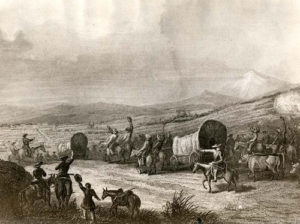 Who is it that has neither seen nor read of Pike’s Peak? If he has not, he has neither traveled nor read the newspapers, and is therefore ignorant of the fact that, that prominent bump (14,147 feet high) upon the earth’s face derived its name from that of Maj Zebulon M. Pike, an explorer, by authority the United States. He was in Santa Fe in 1807. His condition on the route (the future Santa Fe Trail), via the Conejos, across to the Chama, and down that stream past Ojo Caliente and San Juan to Santa Fe, may be inferred from inquiries concerning him and his party; whether those men ragged apparel consisting of overalls, breech cloth leather coats, and without covering for the head, were a tribe living in houses. Pike was promoted to brigadier-general and lost his life in 1813, at the taking of Toronto.
Who is it that has neither seen nor read of Pike’s Peak? If he has not, he has neither traveled nor read the newspapers, and is therefore ignorant of the fact that, that prominent bump (14,147 feet high) upon the earth’s face derived its name from that of Maj Zebulon M. Pike, an explorer, by authority the United States. He was in Santa Fe in 1807. His condition on the route (the future Santa Fe Trail), via the Conejos, across to the Chama, and down that stream past Ojo Caliente and San Juan to Santa Fe, may be inferred from inquiries concerning him and his party; whether those men ragged apparel consisting of overalls, breech cloth leather coats, and without covering for the head, were a tribe living in houses. Pike was promoted to brigadier-general and lost his life in 1813, at the taking of Toronto.
It was a misnomer to call the Santa Fe road a trail. On either side, for miles, a vast expanse of level greensward relieved the solitude that surrounded you – unless, indeed, there was visible a band of Indians, a herd of buffaloes, a prairie dog village, a bunch of antelope, a gray wolf, badger, or long-faced coyotes, with furtive glance, on a swinging trot, putting a deal of real estate between them and supposed danger. A trip over the plains abounded in interest. The rarity of the atmosphere lent enchantment to the scene; the mirage so frequently seen was not the least interesting sight. For hundreds of miles nature denied the wayfarer fuel, but the buffalo in the plentitude of its nature, supplied the omission and no one for the want of fuel was compelled to go supperless to bed.
Thirty-three years ago the incidents of the journey were being related by “a tenderfoot,” who had just arrived in Santa Fe “over land,” from the states. Kit Carson and others were present, and among other astonishing things the newcomer related was, that he had been obliged to cook by a buffalo-chip fire. When doubts were expressed as to the truth of his assertion, “Kit” came to his relief by stating that he had been so frequently reduced to the same necessity that he finally acquired such a taste for the chip that he was induced to throw away the mean and eat the chip.
The writer, the senior of the Belt, inasmuch as he has had some experience, can well credit the statement of the stranger and Carson. The trail is now obliterated, the buffaloes are gone, chips are a thing of the past, railroad cars have superseded the prairie schooner and the carrion crow, on the trail, no longer revels upon the decaying flesh of an overworked ox or mule that fell from exhaustion upon the unfenced expanse west of the Missouri River and east of Santa Fe.
August 25, 2019 | Categories: Old West Myth & Fact | Comments Off on History Of The Santa Fe Trail – Pt 2
Rufus Buck was a
Ute Indian living in the Indian Territory. The Rufus Buck Gang comprised of four Creek Indians and a combination Creek and black. All of them had served time in jail for minor offenses.
Buck supposedly boasted, “That his outfit would make a record that would sweep all the other gangs of the territory into insignificance.” And on July 27, 1895, the gang started a thirteen-day crime spree that did exactly that.
They killed Deputy Marshal John Garrett. They came across a Mrs. Wilson. She was kidnapped and violated. From there they saw Gus Chambers with some horses. When he resisted, the Buck Gang killed him. They next robbed a stockman, taking his clothes and boots. Fortunately, he was able to escape in a hail of bullets. Two days later, they invaded the home of Rosetta Hassan. She was violated in front of her husband and children.
The gang was arrested, and brought before Hanging Judge Isaac Parker, and they were sentenced to be hanged. He scheduled it for July 1, 1896 between nine in the morning and five in the evening.
Quite possibly Judge Parker should have stated an exact time, because, on the day of the hanging, one of the gang members said he wanted to be hanged at ten in the morning so his body could be on the 11:30 train. Rufus Buck protested, saying that if he was hanged that early, there would be a several hour delay before his body could be on the appropriate train. The Rufus Buck Gang then decided they wanted to be hanged separately.
Marshal Crump smiled, set the time for 1:00, and hanged them all at one time.
August 2, 2019 | Categories: Old West Myth & Fact | Comments Off on The Rufus Buck Gang

On July 21, 1870 Deputy U.S. Marshal Wild Bill Hickok was in a bar in Hayes City, Kansas when two of a group of five
Seventh Cavalry troopers suddenly attacked him from behind. It’s not quite clear what provoked the attack, but there is thought it might have had something to do with an encounter Wild Bill had seven months earlier with Tom Custer, brother of George Custer and a member of the Seventh. But one thing is clear, you didn’t want to be on the wrong end of Wild Bill Hickok fighting.
One soldier held Wild Bill’s arms so he couldn’t fight back. A second put the muzzle of his pistol to Wild Bill’s ear and pulled the trigger. Nothing happened.
Now Wild Bill is fighting with super human strength. He got one pistol unholstered and shot one of the soldiers in the wrist and the side. Finally able to point his pistol at the man holding him, Hickok shot him in the knee. Released, Wild Bill then did the old stuntman trick of jumping through the window, breaking glass, rolling on the ground outside, and hightailing it out of the area.
It was a good thing too, because when word of the shooting got back to the Seventh’s headquarters a number of soldiers headed into Hayes City looking for Wild Bill. General Sheridan even ordered Hickok’s arrested. But it never took place.
The event, just as it happened, was something most people would find an amazing feat. But as with most of Hickok’s adventures, it immediately took on even larger proportions. At first newspapers said all five soldiers attacked Hickok. And some ten years later Wild Bill had taken on 15 troopers, killing 3, and being wounded 7 times. Now that’s a story you could tell with pride.
July 22, 2019 | Categories: Old West Myth & Fact | Comments Off on Wild Bill Hickok Fighting
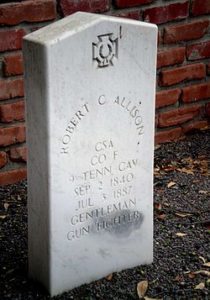 July 26, 1887, The Globe Live Stock Journal, Dodge City, Kansas – Reporting on Clay Allison Dies: Clay Allison, a brave, true-hearted and oft-times dangerously reckless man, when in his cups, has at last died with his boots on, but not by the pistol route. He fell from his wagon in Texas, some days ago, the wheels of the same running over his neck and breaking it. The career of Clay Allison is perhaps unparalleled in the western country and should be written up by some one conversant with it.
July 26, 1887, The Globe Live Stock Journal, Dodge City, Kansas – Reporting on Clay Allison Dies: Clay Allison, a brave, true-hearted and oft-times dangerously reckless man, when in his cups, has at last died with his boots on, but not by the pistol route. He fell from his wagon in Texas, some days ago, the wheels of the same running over his neck and breaking it. The career of Clay Allison is perhaps unparalleled in the western country and should be written up by some one conversant with it.
All of our old timers knew Clay Allison. He knew no fear, was a good looking man. To incur his enmity was about equivalent to a death sentence. He contended always that he had never killed a man willingly; but that the necessity in every instance had been thrust upon him. He was expert with his revolver, and never failed to come out first best in a deadly encounter. Whether this brave, genteel border man was in truth a villain or a gentleman is a question that many who knew him never settled to their own satisfaction. Certain it is that many of his stern deeds were for the right as he understood the right to be.
By 1883, Allison had sold his ranch and moved to Pope’s Wells (a landmark along the Goodnight–Loving Trail), purchasing a ranch near the Pecos River crossing of the Texas-New Mexico line (50 miles northwest of Pecos, Texas). Clay and his wife, “Dora,” had two daughters: Patti Dora Allison (born on August 9, 1885; Cimarron, New Mexico), and Clay Pearl Allison (born February 10, 1888; Pecos, Texas—seven months after her father’s death).
In a special ceremony held on August 28, 1975, Clay Allison’s remains were re-interred at Pecos Park, just west of the Pecos Museum. His grave marker (which has the incorrect birth date of 1840), reads:
ROBERT C ALLISON
CSA
CO F
9th TENN CAV
SEP 2 1840
JUL 3 1887
GENTLEMAN
GUN FIGHTER |
A second marker was later placed at the foot of the grave (see below); with the added phrase: “He never killed a man that did not need killing”.
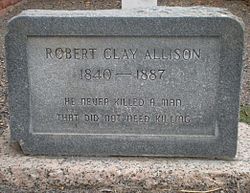
May 27, 2019 | Categories: Old West Myth & Fact | Comments Off on Clay Allison Dies

The Lincoln County War was going full tilt. William Brady was the sheriff of
Lincoln County. Brady was known to be in the pocket of the Murphy-Dolan faction… the bad guys as far as Billy the Kid was concerned. The next sequence of events unfold as Billy the Kid’s Regulators come to the forefront.
During this time, Billy the Kid had formed his “regulators,” a semi-legal group to fight what he considered was the corruption in the county. And, for the most part, the average local looked favorably upon the regulators.
On the morning of April Fools Day 1878,
Sheriff William Brady was walking down the Main Street of Lincoln with four of his deputies.
Then, from behind an adobe wall, guns started barking. It’s obvious that Sheriff Brady was the main target, because in a matter of seconds, he had more than a dozen holes in him.
Brady and Billy the Kid had history. Billy blamed Brady for the death of his friend
John Tunstall, and in February of that year, Billy had tried to arrest Brady. But, Brady turned the tables on the Kid, and the Kid ended up in jail.
It was revenge through and through. When the shooting died down, Billy the Kid walked up to the body of Sheriff Brady. Some say Billy was looking for arrest warrants for Billy and the regulators. Others say Billy was looking for the Winchester rifle Brady had taken from him back in February.
When a bullet shot from hiding nicked Billy’s hip, Billy wisely returned to cover and the regulators left town.
Although Billy was able to get his vengeance, the outcome of the event wasn’t good for him. Because of the way it happened, Billy started losing the sympathy of the locals, and they began questioning the legality of his regulators.
April 8, 2019 | Categories: Old West Myth & Fact | Comments Off on William Brady and Billy the Kid’s Regulators
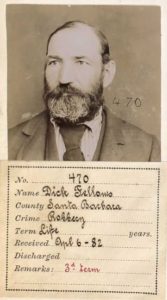 We see outlaws in the movies riding at breakneck speed to chase down a stagecoach, and then jump from the horse to the stagecoach to encounter the driver and guard. All outlaws weren’t that good of horsemen. One such person got out of San Quentin Prison on this date back in 1881. His name was Dick Fellows.
We see outlaws in the movies riding at breakneck speed to chase down a stagecoach, and then jump from the horse to the stagecoach to encounter the driver and guard. All outlaws weren’t that good of horsemen. One such person got out of San Quentin Prison on this date back in 1881. His name was Dick Fellows.
Raised in Kentucky, Dick Fellows…An alias…came to California, and falling on hard times decided to rob stagecoaches. He picked the correct stage. It was carrying $240,000. However, as he was getting ready to go after the stage, the stolen horse he was riding threw him, and he was knocked unconscious.
Not one to give up, Fellows stole another horse and held up the next stage. He was successful. After the stage left, he tried to lift the strong box on his horse. The horse startled and raced off.
With night coming on he started walking with the strong box. Next he fell over a high bluff, knocking himself unconscious a second time. He woke up with a broken leg and foot.
Although the strong box has $1800 in it, he never got a chance to spend it, before Wells Fargo Detectives caught up with him.
When he got out of San Quentin, I believe most people would take the hint and go straight. But not Fellows. He went back to robbing stages, only to be caught again and sentenced to life in Folsom Prison.
Fellows devoted part of his time there to teaching a course in moral philosophy to his fellow inmates. Pardoned in 1908 at the age of 62, he returned to his home in Kentucky and faded from the historical record. It is tempting to lampoon Fellows for his inept horsemanship and astonishingly bad luck, but as one biographer noted, “For daring, he is the equal of any outlaws with whom I ever had dealings.”
March 25, 2019 | Categories: Old West Myth & Fact | Comments Off on Dick Fellows – Bad Outlaw Horseman

The Anderson family resided in Jefferson County, Missouri. Although they were farmers, the Anderson men had a tendency to augment their income with armed robbery. From these family roots sprung Bloody Bill Anderson.
In 1862, Confederate Quantrill raided the town where the Andersons lived. As a result, Union troops came to the area, and four days later, two of the Anderson men were hanged as Confederate sympathizers. This angered 25-year-old Bill Anderson to the point that he dropped his plow and joined Quantrill’s raiders.
Later Bill Anderson’s three sisters were arrested for being spies. And, while in prison, the building collapsed killing one of them. As you can imagine, this pushed an angry Bill Anderson over the edge. Any civility he had was gone to the point people started calling him “Bloody” Bill Anderson. Becoming one of Quantrill’s chief lieutenants, at the massacre of Lawrence, Kansas, the men under his command supposedly killed more people than anyone else. At a raid in Centralia, Missouri, he was responsible for prisoners being stripped and shot.
October 27, 1864, just a year and a half after he joined Quantrill, Bloody Bill Anderson was shot and killed by Union soldiers. A silk scarf reportedly was found with 53 knots in it. Supposedly, the scarf belonged to the sister who was killed with the collapse of the jail. And each knot represented a person killed.
But then there were other reports that someone else was riding Bloody Bill’s horse, and he was shot instead. Bloody Bill realizing this was a good opportunity to get the bloodhounds off his back, quietly went to Texas and then Oklahoma. I’m sure he met up with Jesse James, Billy the Kid, Butch Cassidy and all the other outlaws who were also fortunate enough to have had someone else die in their place.
February 13, 2019 | Categories: Old West Myth & Fact | Comments Off on Bloody Bill Anderson

On April 1, 1877, a young prospector named Ed Schieffelin arrived at Fort Yachuca in southern Arizona. He told the soldiers he was going into Apache country and trying his hand at prospecting. They told him that the only thing he would find there would be his tombstone. That is how
Tombstone, Arizona was named.
By October he had run out of supplies and money. Not willing to give up, he kept looking, and was finally rewarded with the discovery of a silver vein 7 inches wide by 50 feet long. Ed Schieffelin named his mine the “Lucky Cuss.” Remembering the remarks of the soldiers that all he would find would be his tombstone, Ed, along with his brother Al, founded the Tombstone Mining District.
As soon as the word got out of a silver strike, prospectors came from everywhere. Next came the gamblers and ladies of the evening. Within 3 years the town comprised of almost 500 buildings, with more than 100 of them selling liquor, and half of these places were “houses of ill fame.”
Tombstone did have two newspapers and a hall built to attract legitimate theatrical endeavors. There were also churches and schools that incidentally, were supported by a tax on the gambling halls and houses of ill repute.
Nine years after that first discovery of silver, water flooded the mines, and the population of Tombstone dwindled down to a few hardy souls. But, during that short period, the people who came through Tombstone read like a who’s who of the Old West. This was not only because of the attraction of silver, but the rest of the west was settling down, and this desert town in the Arizona Territory was the last hurrah for wild men looking for excitement.
January 23, 2019 | Categories: Old West Myth & Fact | Comments Off on How Tombstone, Arizona Was Named
In October of 1887 a vote was held in Gray County, Kansas to determine the county seat. The winner was Cimarron. But the citizens of Ingalls weren’t happy with the outcome. And they took their case to the courts. For over a year the courts did nothing, which lead to the County Seat War.

Finally Asa Soule, from Ingalls, decided to take the situation into his own hands. He figured that as the crown or miter was the authority of a king, the records of a county were the authority of a county seat. So, on January 11, 1889 he deputized a group of men to steal the county records. These lawmen weren’t novices. They included Bill Tilghman, Neal Brown and two of
Bat Masterson’s brothers, Jim and Tom.
Early Sunday morning the group rode quietly into
Cimarron. Neal Brown and the two Mastersons started carrying out the records as the others stood guard. Then an alarm was sounded, and guns started firing. The three record carriers were caught inside the courthouse. The rest got away with the records. More than two hundred men started shooting at the courthouse. In the process, one citizen was killed.
For more than 24 hours the men were trapped inside. Then mysteriously a truce was called and the three men were allowed to leave town unscathed. What happened? Well, Bat Masterson heard about his brothers’ plight, and he telegraphed Cimarron stating, if either of his brothers were hurt he would “hire a train and come in with enough men to blow Cimarron off the face of Kansas.”
Oh yes, four years later another election was held and Cimarron again won.
January 19, 2019 | Categories: Old West Myth & Fact | Comments Off on County Seat War

Wyatt Earp had left behind his days in Tombstone. He was now living as a gentleman in San Francisco. Because of his interest in boxing and his celebrity status, on December 2, 1896, Wyatt was asked to referee a championship-boxing match between Fitzsimmons and Sharkey. The purse was $10,000. Winner take all. Here is the story of Wyatt Earp, Boxing Referee:
Things didn’t start out well for Wyatt. He arrived at the arena with a gun. It had to be taken away by the police.
Boxing was considered the sport of the common man… but this match was different. Prominent businessmen, police commissioners and superior court judges were there. Even women attended the event… Most wore veils, but some were brazen enough to go bare faced.
Fitzsimmons was the favorite, and most of the money was on him. Even though Fitzsimmons told his corner men at the end of the third round that he would finish Sharkey in the next round, it didn’t happen. Sharkey held up his side of the fight until the seventh. And then he started fading.
Now Sharkey had a reputation of sneaking in low blows, and maybe this experience was used to accomplish what happened next, because in the eighth round Sharkey, after a mix-up of blows, fell to the mat claiming a foul. Referee Earp, agreed, and declared Sharkey the winner.
No one in the arena saw the foul, and people started mumbling about a fixed fight. Fitzsimmon’s people took it to court. The judge declared that since boxing wasn’t legal, the courts were not in a position to make a determination on the outcome of the fight.
Proof of a fixed fight was never established. But right after the fight, Wyatt Earp chose to leave the city by the bay.
December 11, 2018 | Categories: Old West Myth & Fact | Comments Off on Wyatt Earp, Boxing Referee
 940, the famous cowboy actor Tom Mix is killed in a freak car accident near his ranch in Florence, Arizona. He was driving his single-seat roadster with luggage on the rear shelf of the car. Tom was traveling along a straight desert road, when he unknowingly came to a bridge spanning a shallow gully that was out. When his car went down into the gully a heavy suitcase flew off the rear shelf of his car and crushed him.
940, the famous cowboy actor Tom Mix is killed in a freak car accident near his ranch in Florence, Arizona. He was driving his single-seat roadster with luggage on the rear shelf of the car. Tom was traveling along a straight desert road, when he unknowingly came to a bridge spanning a shallow gully that was out. When his car went down into the gully a heavy suitcase flew off the rear shelf of his car and crushed him. How did Wild Bill Hickok’s first job as sheriff go for him? Well, on September 27 back in 1869, Ellis County Sheriff Wild Bill Hickok and his deputy responded to a disturbance by a local ruffian named Samuel Strawhun and several of his drunken buddies at John Bitter’s Beer Saloon in Hays City, Kansas. Hickok ordered the men to stop, Strawhun turned to attack him, and Hickok shot and killed him.
How did Wild Bill Hickok’s first job as sheriff go for him? Well, on September 27 back in 1869, Ellis County Sheriff Wild Bill Hickok and his deputy responded to a disturbance by a local ruffian named Samuel Strawhun and several of his drunken buddies at John Bitter’s Beer Saloon in Hays City, Kansas. Hickok ordered the men to stop, Strawhun turned to attack him, and Hickok shot and killed him. Back in 1866 Robert Leroy Parker was born in Beaver, Utah Territory. But we know him as Butch Cassidy.
Back in 1866 Robert Leroy Parker was born in Beaver, Utah Territory. But we know him as Butch Cassidy.
 By the mid 1850’s the Pacific Northwest was becoming heavily settled by whites. The area had traditionally been occupied by the Duwamish and Suquamish Indian tribes. They were headed by a chief from both tribes by the name of Chief Seattle. As the early settlers came to the area Seattle welcomed them, and the settlers treated his tribes with kindness.
By the mid 1850’s the Pacific Northwest was becoming heavily settled by whites. The area had traditionally been occupied by the Duwamish and Suquamish Indian tribes. They were headed by a chief from both tribes by the name of Chief Seattle. As the early settlers came to the area Seattle welcomed them, and the settlers treated his tribes with kindness.  On July 17, 1870 Deputy U.S. Marshal Wild Bill Hickok was in a bar in Hayes City, Kansas when two of a group of five Seventh Cavalry troopers suddenly attacked him from behind. It’s not quite clear what provoked the attack, but there is thought it might have had something to do with an encounter Wild Bill had earlier with Tom Custer, brother of George Custer and a member of the Seventh. So here’s the story – Wild Bill Hickok shoots soldiers.
On July 17, 1870 Deputy U.S. Marshal Wild Bill Hickok was in a bar in Hayes City, Kansas when two of a group of five Seventh Cavalry troopers suddenly attacked him from behind. It’s not quite clear what provoked the attack, but there is thought it might have had something to do with an encounter Wild Bill had earlier with Tom Custer, brother of George Custer and a member of the Seventh. So here’s the story – Wild Bill Hickok shoots soldiers. On July 1, 1854 the first cattle driven from Texas arrived in New York City. New York City? That’s right New York City. Here’s the story of the Texas – New York Cattle Drive.
On July 1, 1854 the first cattle driven from Texas arrived in New York City. New York City? That’s right New York City. Here’s the story of the Texas – New York Cattle Drive.  In the past we have told the stories of two of Arizona’s lost treasures. One was the Lost Dutchman’s Mine located in the Superstition Mountains a short distance from a busy Phoenix freeway. Another was a treasure comprised of gold coins lost when a dam broke on the Hassayampa River just north of Phoenix.
In the past we have told the stories of two of Arizona’s lost treasures. One was the Lost Dutchman’s Mine located in the Superstition Mountains a short distance from a busy Phoenix freeway. Another was a treasure comprised of gold coins lost when a dam broke on the Hassayampa River just north of Phoenix.


 Although Western movies often show a villain or hero’s dexterity with a pistol, much of that dexterity or trick shooting was fiction. But there was one incident where it may have taken place. It was when Curly Bill killed Fred White.
Although Western movies often show a villain or hero’s dexterity with a pistol, much of that dexterity or trick shooting was fiction. But there was one incident where it may have taken place. It was when Curly Bill killed Fred White. The year was 1877. The location was Denver, Colorado. In May, the locals were entertained by midget Tom Thumb in P. T. Barnum’s stage show. Three months later, there was a performance of another type that entertained some of the Denverites. It was the first of its kind recorded in the Old West; one where there are women dueling.
The year was 1877. The location was Denver, Colorado. In May, the locals were entertained by midget Tom Thumb in P. T. Barnum’s stage show. Three months later, there was a performance of another type that entertained some of the Denverites. It was the first of its kind recorded in the Old West; one where there are women dueling. Who is it that has neither seen nor read of Pike’s Peak? If he has not, he has neither traveled nor read the newspapers, and is therefore ignorant of the fact that, that prominent bump (14,147 feet high) upon the earth’s face derived its name from that of Maj Zebulon M. Pike, an explorer, by authority the United States. He was in Santa Fe in 1807. His condition on the route (the future Santa Fe Trail), via the Conejos, across to the Chama, and down that stream past Ojo Caliente and San Juan to Santa Fe, may be inferred from inquiries concerning him and his party; whether those men ragged apparel consisting of overalls, breech cloth leather coats, and without covering for the head, were a tribe living in houses. Pike was promoted to brigadier-general and lost his life in 1813, at the taking of Toronto.
Who is it that has neither seen nor read of Pike’s Peak? If he has not, he has neither traveled nor read the newspapers, and is therefore ignorant of the fact that, that prominent bump (14,147 feet high) upon the earth’s face derived its name from that of Maj Zebulon M. Pike, an explorer, by authority the United States. He was in Santa Fe in 1807. His condition on the route (the future Santa Fe Trail), via the Conejos, across to the Chama, and down that stream past Ojo Caliente and San Juan to Santa Fe, may be inferred from inquiries concerning him and his party; whether those men ragged apparel consisting of overalls, breech cloth leather coats, and without covering for the head, were a tribe living in houses. Pike was promoted to brigadier-general and lost his life in 1813, at the taking of Toronto.
 On July 21, 1870 Deputy U.S. Marshal Wild Bill Hickok was in a bar in Hayes City, Kansas when two of a group of five Seventh Cavalry troopers suddenly attacked him from behind. It’s not quite clear what provoked the attack, but there is thought it might have had something to do with an encounter Wild Bill had seven months earlier with Tom Custer, brother of George Custer and a member of the Seventh. But one thing is clear, you didn’t want to be on the wrong end of Wild Bill Hickok fighting.
On July 21, 1870 Deputy U.S. Marshal Wild Bill Hickok was in a bar in Hayes City, Kansas when two of a group of five Seventh Cavalry troopers suddenly attacked him from behind. It’s not quite clear what provoked the attack, but there is thought it might have had something to do with an encounter Wild Bill had seven months earlier with Tom Custer, brother of George Custer and a member of the Seventh. But one thing is clear, you didn’t want to be on the wrong end of Wild Bill Hickok fighting. July 26, 1887, The Globe Live Stock Journal, Dodge City, Kansas – Reporting on Clay Allison Dies: Clay Allison, a brave, true-hearted and oft-times dangerously reckless man, when in his cups, has at last died with his boots on, but not by the pistol route. He fell from his wagon in Texas, some days ago, the wheels of the same running over his neck and breaking it. The career of Clay Allison is perhaps unparalleled in the western country and should be written up by some one conversant with it.
July 26, 1887, The Globe Live Stock Journal, Dodge City, Kansas – Reporting on Clay Allison Dies: Clay Allison, a brave, true-hearted and oft-times dangerously reckless man, when in his cups, has at last died with his boots on, but not by the pistol route. He fell from his wagon in Texas, some days ago, the wheels of the same running over his neck and breaking it. The career of Clay Allison is perhaps unparalleled in the western country and should be written up by some one conversant with it. The Lincoln County War was going full tilt. William Brady was the sheriff of Lincoln County. Brady was known to be in the pocket of the Murphy-Dolan faction… the bad guys as far as Billy the Kid was concerned. The next sequence of events unfold as Billy the Kid’s Regulators come to the forefront.
The Lincoln County War was going full tilt. William Brady was the sheriff of Lincoln County. Brady was known to be in the pocket of the Murphy-Dolan faction… the bad guys as far as Billy the Kid was concerned. The next sequence of events unfold as Billy the Kid’s Regulators come to the forefront. We see outlaws in the movies riding at breakneck speed to chase down a stagecoach, and then jump from the horse to the stagecoach to encounter the driver and guard. All outlaws weren’t that good of horsemen. One such person got out of San Quentin Prison on this date back in 1881. His name was Dick Fellows.
We see outlaws in the movies riding at breakneck speed to chase down a stagecoach, and then jump from the horse to the stagecoach to encounter the driver and guard. All outlaws weren’t that good of horsemen. One such person got out of San Quentin Prison on this date back in 1881. His name was Dick Fellows. The Anderson family resided in Jefferson County, Missouri. Although they were farmers, the Anderson men had a tendency to augment their income with armed robbery. From these family roots sprung Bloody Bill Anderson.
The Anderson family resided in Jefferson County, Missouri. Although they were farmers, the Anderson men had a tendency to augment their income with armed robbery. From these family roots sprung Bloody Bill Anderson. On April 1, 1877, a young prospector named Ed Schieffelin arrived at Fort Yachuca in southern Arizona. He told the soldiers he was going into Apache country and trying his hand at prospecting. They told him that the only thing he would find there would be his tombstone. That is how Tombstone, Arizona was named.
On April 1, 1877, a young prospector named Ed Schieffelin arrived at Fort Yachuca in southern Arizona. He told the soldiers he was going into Apache country and trying his hand at prospecting. They told him that the only thing he would find there would be his tombstone. That is how Tombstone, Arizona was named. Finally Asa Soule, from Ingalls, decided to take the situation into his own hands. He figured that as the crown or miter was the authority of a king, the records of a county were the authority of a county seat. So, on January 11, 1889 he deputized a group of men to steal the county records. These lawmen weren’t novices. They included Bill Tilghman, Neal Brown and two of Bat Masterson’s brothers, Jim and Tom.
Finally Asa Soule, from Ingalls, decided to take the situation into his own hands. He figured that as the crown or miter was the authority of a king, the records of a county were the authority of a county seat. So, on January 11, 1889 he deputized a group of men to steal the county records. These lawmen weren’t novices. They included Bill Tilghman, Neal Brown and two of Bat Masterson’s brothers, Jim and Tom.
 Wyatt Earp had left behind his days in Tombstone. He was now living as a gentleman in San Francisco. Because of his interest in boxing and his celebrity status, on December 2, 1896, Wyatt was asked to referee a championship-boxing match between Fitzsimmons and Sharkey. The purse was $10,000. Winner take all. Here is the story of Wyatt Earp, Boxing Referee:
Wyatt Earp had left behind his days in Tombstone. He was now living as a gentleman in San Francisco. Because of his interest in boxing and his celebrity status, on December 2, 1896, Wyatt was asked to referee a championship-boxing match between Fitzsimmons and Sharkey. The purse was $10,000. Winner take all. Here is the story of Wyatt Earp, Boxing Referee:




